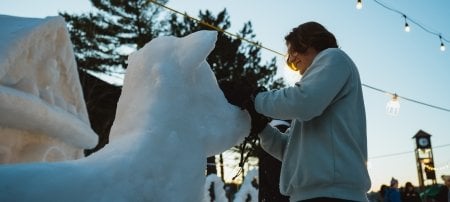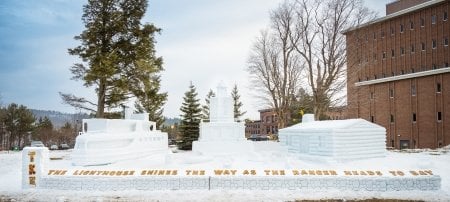Local Snowflake Makes Good
A local specimen is one of four Holiday Snowflakes commemorative postage stamps to be issued by the U.S. Postal Service Thursday, Oct. 5.
The official kickoff will be at the New York Mega StampShow at Madison Square Garden and not, unfortunately, in Houghton, where the snowflake in question was photographed by Caltech physicist Kenneth Libbrecht during a January 2005 visit to Michigan Tech.
He came to the university at the behest of physics professor John Jaszczak. "I found his book 'The Snowflake: Winter's Secret Beauty' in the Campus Store by chance, and it was amazing," he recalls. Thinking that Libbrecht would be a good speaker to host in the heart of snow country, Jaszczak asked Rozsa Center Director Valerie Pegg to invite him to give a lecture. As it turned out, Libbrecht had long been wanting to come to the U.P., so in addition to giving a talk, he spent two weeks in Houghton, much of it capturing snowflakes with his cold-weather camera equipment outside the Best Western Franklin Square Inn.
Libbrecht himself never expected his snowflakes to be reproduced millions of times over on postage stamps. "It was quite a surprise and a delight to get that phone call," he said. "I gave one of the guys from the post office a selection of snowflakes to choose from, and those are the ones he picked." Of the other three, one is from Alaska and two are from Ontario.
Because of its relatively warm temperatures, the Copper Country doesn't always produce the most beautiful snowflakes, Libbrecht notes, though he did find some unusual formations he calls capped needles that he hasn't seen anywhere else. The finest, most delicate crystals form in the super-cold conditions more typical of Amasa.
Nevertheless, he says, "My new book, 'Field Guide to Snowflakes,' includes a lot of pictures from your neck of the woods.
"Yours aren't the best snowflakes I've seen, but you make up for it in volume," he adds. "Boy, do you ever. I practically had to carry a shovel everywhere."
Libbrecht, who studies gravitational waves, watches snowflakes for the love of it. "I just find them kind of interesting," he says. "I encourage people to get a magnifying glass and take a closer look."
In any event, Jaszczak, who is the adjunct curator of the Seaman Mineral Museum, is thrilled to see a local snowflake on a postage stamp. "I'm excited about it," he says. "It is a Michigan mineral."
Michigan Technological University is an R1 public research university founded in 1885 in Houghton, and is home to nearly 7,500 students from more than 60 countries around the world. Consistently ranked among the best universities in the country for return on investment, Michigan's flagship technological university offers more than 185 undergraduate and graduate degree programs in science and technology, engineering, computing, forestry, business, health professions, humanities, mathematics, social sciences, and the arts. The rural campus is situated just miles from Lake Superior in Michigan's Upper Peninsula, offering year-round opportunities for outdoor adventure.




Comments